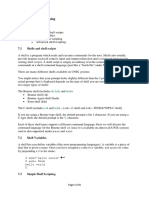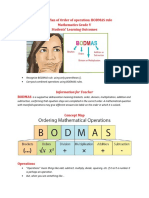3.1. Shell Scripting Introduction
Uploaded by
rexziegen3.1. Shell Scripting Introduction
Uploaded by
rexziegen1.
OVERVIEW
Time is precious. It is non-sense-ical to waste time typing a frequently used sequence of commands at a command prompt, more especially if they are abnormally long or complex. Scripting is a way by which one can alleviate this necessity by automating these command sequences in order to make ones life at the shell easier and more productive. Scripting is all about making the computer, the tool, do the work. opefully by the end of this tutorial you should have a good idea of the kinds of scripting languages available for !nix and how to apply them to your problems.
2. ATMOSPHERE
In order to peruse this tutorial with ease it is probably necessary to know a little bit about how !nix works, if you are new to !nix you should read the documentation" Configuring A Unix Working Environment #..$unixenvars$unixenvarshome.html%, if you are not new to !nix you should browse it to check that you know everything it discusses. !nix contains many wonderful and strange commands that can be very useful in the world of scripting, the more of the tools you know and the better you know them, the more use you will find for them in your scripting. &ost of the !nix commands and many of the builtin commands have man pages, man pages contain the usage instructions and other stuff pertaining to the parent tool. They are not always very clear and may require reading several times. In order to access a man page in !nix the following command sequence is applied"
man command
If a man page exists for the command specified the internal viewer will be invoked and you will be able to read about the various options and usage instructions etc.
3. Shell Scripting
3.1. Shell Scripting Introduction
!nix uses shells to accept commands given by the user, there are quite a few different shells available. The most commonly used shells are S '(ourne S ell) *S '* S ell) and +S '+orn S ell), most of the other shells you encounter will be variants of these shells and will share the same syntax, +S is based on S and so is (,S '(ourne again shell). T*S '-xtended * S ell) is based on *S . The various shells all have built in functions which allow for the creation of shell scripts, that is, the stringing together of shell commands and constructs to automate what can be automated in order to make life easier for the user. .ith all these different shells available, what shell should we script in/ That is debatable. 0or the purpose of this tutorial we will be using S because it is practically guaranteed to be available on most !nix systems you will encounter or be supported by the S based shells. 1our default shell may not be S . 0ortunately we do not have to be using a specific shell in order to exploit its features because we can specify the shell we want to interpret our shell script within the script itself by including the following in the first line.
#!/path/to/shell
!sually anything following '2) is interpreted as a comment and ignored but if it occurs on the first line with a '3) following it is
treated as being special and the filename following the '3) is considered to point to the location of the shell that should interpret the 4 script. .hen a script is 5executed5 it is being interpreted by an invocation of the shell that is running it. ence the shell is said to be running non-interactively, when the shell is used 5normally5 it is said to be running interactively.
Note
There are many variations on the basic commands and extra information which is too specific to be mentioned in this short tutorial, you should read the man page for your shell to get a more comprehensive idea of the options available to you. This tutorial will concentrate on highlighting the most often used and useful commands and constructs.
3.2. Shell Scripting B !ic!
3.2.1. "o## nd Redirection nd Pipeline!
(y default a normal command accepts input from standard input, which we abbreviate to stdin, standard input is the command line in the form of arguments passed to the command. (y default a normal command directs its output to standard output, which we abbreviate to stdout, standard output is usually the console display. 0or some commands this may be the desired action but other times we may wish to get our input for a command from somewhere other than stdin and direct our output to somewhere other than stdout. This is done by redirection" 6 .e use > to redirect stdout to a file, for instance, if we wanted to redirect a directory listing generated by the ls we could do the following"
ls > file
6 .e use < to specify that we want the command immediately before the redirection symbol to get its input from the source specified immediately after the symbol, for instance, we could redirect the input to grep'which searches for strings within files) so that it comes from a file like this"
grep searchterm < file
6 .e use >> to append stdout to a file, for instance, if we wanted to append the date to the end of a file we could redirect the output from date like so"
date >> file
You might also like
- Powershell: The ultimate beginner's guide to Powershell, making you a master at Windows Powershell command line fast!From EverandPowershell: The ultimate beginner's guide to Powershell, making you a master at Windows Powershell command line fast!5/5 (1)
- The Shell and Shell Scripting: Echo $SHELL - To See The Working Shell in SSHNo ratings yetThe Shell and Shell Scripting: Echo $SHELL - To See The Working Shell in SSH12 pages
- Introduction To UNIX: Lecture Eight: 8.1 ObjectivesNo ratings yetIntroduction To UNIX: Lecture Eight: 8.1 Objectives9 pages
- Introduction To UNIX: Lecture Eight: 8.1 ObjectivesNo ratings yetIntroduction To UNIX: Lecture Eight: 8.1 Objectives9 pages
- Part 1 Linux Chapter 5 Shell ProgrammingNo ratings yetPart 1 Linux Chapter 5 Shell Programming25 pages
- Shell Scripting Tutorial: How To Create Shell Script in Linux/UnixNo ratings yetShell Scripting Tutorial: How To Create Shell Script in Linux/Unix6 pages
- Basics of UNIX Shells (Bourne Shell, Korn Shell, C Shell)No ratings yetBasics of UNIX Shells (Bourne Shell, Korn Shell, C Shell)64 pages
- The UNIX Shells (Bourne Shell, Korn Shell, C Shell)No ratings yetThe UNIX Shells (Bourne Shell, Korn Shell, C Shell)61 pages
- Linux Shell Scripting Simplified: A Practical Guide with ExamplesFrom EverandLinux Shell Scripting Simplified: A Practical Guide with ExamplesNo ratings yet
- UNIX Shell Scripting Interview Questions, Answers, and Explanations: UNIX Shell Certification ReviewFrom EverandUNIX Shell Scripting Interview Questions, Answers, and Explanations: UNIX Shell Certification Review4.5/5 (4)
- Docker Tutorial for Beginners: Learn Programming, Containers, Data Structures, Software Engineering, and CodingFrom EverandDocker Tutorial for Beginners: Learn Programming, Containers, Data Structures, Software Engineering, and Coding3/5 (2)
- 15ECE202 Digital Circuits and Systems: Answer All QuestionsNo ratings yet15ECE202 Digital Circuits and Systems: Answer All Questions2 pages
- Solution To Problem of Vi Editor of Ubuntu (Have Syntax and Keyboard Correction)No ratings yetSolution To Problem of Vi Editor of Ubuntu (Have Syntax and Keyboard Correction)4 pages
- Spoto Ccie Lab Rs v5.0 Ts2 Bt1 Qbook v1.0No ratings yetSpoto Ccie Lab Rs v5.0 Ts2 Bt1 Qbook v1.08 pages
- Basic Linux Commands - Learn Basic Linux Commands With Examples - ExpertsLogInNo ratings yetBasic Linux Commands - Learn Basic Linux Commands With Examples - ExpertsLogIn19 pages
- 98-375 HTML5 Application Development Fundamentals - Skills MeasuredNo ratings yet98-375 HTML5 Application Development Fundamentals - Skills Measured2 pages
- Project Advice Note: Goods Inwards Checks of Signalling Records PurposeNo ratings yetProject Advice Note: Goods Inwards Checks of Signalling Records Purpose5 pages
- How To Install SQL Server 2017 On RedHat Linux Without InternetNo ratings yetHow To Install SQL Server 2017 On RedHat Linux Without Internet8 pages
- The Incredible Power of Post Selection (Scott Aaronson)100% (1)The Incredible Power of Post Selection (Scott Aaronson)33 pages
- A Study On Funds Flow Statement Analysis at Lanco Industries LTD SrikalahasthiNo ratings yetA Study On Funds Flow Statement Analysis at Lanco Industries LTD Srikalahasthi14 pages

























































































